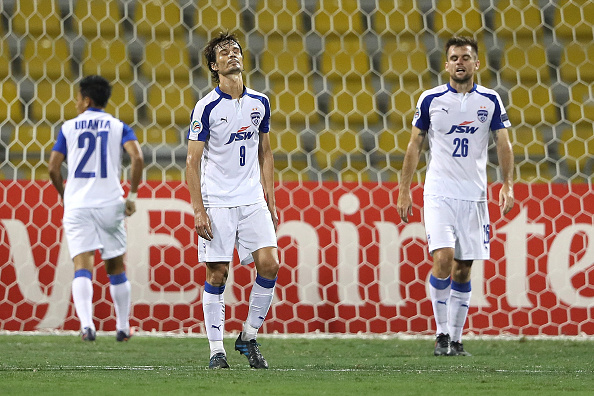
Analysis: Where did Bengaluru FC lose the AFC Cup final?

To say that Bengaluru FC did an amazing job to reach the finals of the AFC Cup itself is an understatement. Having ousted heavyweights like Kitchee FC, Tampines Rovers and last year’s champions Johor Darul Ta’zim in the knockout rounds to reach the final, they put up a brave fight in the finals against a competent Air Force Club as they went down by a solitary goal. For a club that is just 3 years old, the achievements they have amassed over time speak volumes.
While other corporate teams introduced by the AIFF have struggled to establish themselves in the I-League, Bengaluru’s performances nationally as well as continently, can be credited to the professionalism they have displayed on and off the field. A chunk of the credit for the on-field performances goes to former and current managers, Ashley Westwood and Albert Roca respectively.
Bengaluru FC’s biggest strength from the outset has been their discipline, with Westwood keeping the onus on developing a side that was well-organised across all parts of the field. Since his arrival, Roca - a former Barcelona assistant manager - has tried to incorporate the Catalonian style of game, starting off moves from the back and has also focussed on solidifying the defence.
Roca was appointed prior to the quarter-final tie against Tampines Rovers. Before his appointment, Bengaluru had conceded 12 goals in the group stages and round of 16, in the 5 games that followed, Bengaluru conceded just 3 against quality oppositions. The back four of Rino Anto, John Johnson, Juanan and Nishu Kumar alongside Amrinder Singh under the bar was rock-solid and pivotal to Bengaluru’s progress through the knockout phases.
Even in the final, the Bengaluru backline did a fantastic job and they rarely gave the dangerous Iraqis the space and time in the box to carve open chances. They kept their lines well with either Cameron Watson or Alvaro Rubio dropping in deep to assist the backline while the full-backs dealt with the opposition wingers out wide. Even though the Iraqis threatened with their movement near the box, Bengaluru never really looked under threat of conceding a goal especially with the way they kept defending.
However it was this stability at the back that affected and ultimately cost Bengaluru the game, when Roca decided to introduce Seiminlen Doungel and Udanta Singh for Alwyn George and Nishu Kumar in the 64th minute. The team shifted to a 3-5-2 with Watson dropping into centre-back and Rino and Udanta playing as the wing-backs.
On the change, Roca said in his post-match conference, “In the second half we tried to create more problems for the opposition. We knew scoring a goal and defending well will be the only possibility to win the game. It was really difficult to resist them.”

Although it did seem that everything was going according to Roca’s plan with Bengaluru making a quick couple of attacking moves, the alarm bells were ringing with the very first move the Iraqis made into the Bengaluru defence. The defending was last ditch and it seemed like the backline had not responded to the sudden shift in formation.
Watson’s move to the backline suddenly gave the Ahmed Kadhim - who struggled to create any sort of impact until then - a lot of liberty to dictate play. The Bengaluru defenders, who were having a good game until then, suddenly lost the plot. In the 70th minute, Kadhim - relishing in his new found freedom - played in the livewire Amjad Radhi who skipped through a host of Bengaluru FC players, rounded Ralte and put the ball in a platter for Ahmed Hammadi to score.
Now, you cannot help but wonder whether this goal could have been avoided if the 4-man backline was still intact; Watson’s presence in midfield could have limited Kadhim’s foray into dangerous areas in the first place, while Rubio and Johnson looked as if they were both expecting the other to close down on Radhi.
Meanwhile, Rino who was miles away when Radhi received the pass initially was too reluctant to track back, probably owing to his wing-back role. If not for the wasteful finishing off the Iraqis, the scoreline would have been worse as they opened up at least half a dozen more chances after the goal. The backline that looked solid until the change in formation suddenly became shambolic.
Although it is appreciable of Roca to have made such an attacking change, looking back, it feels as though it would have been better to follow a tad more careful approach. George was a bit disappointing and introducing either Udanta or Len for him to induce a bit of pace into the attack was reasonable. However removing Nishu - who was decent if not solid - for Len, could have been avoided, as that was what prompted the decisive change in formation.
Having said all this, there is no reason to take away any credit from either Roca or any of the players. Bengaluru FC have played some amazing football over the course of the tournament and inspired many with their performances. It is not often the entire nation comes together to support an Indian football club and Bengaluru FC has succeeded to stamp India’s presence in the Asian scene.
Now as fans, we can just hope Bengaluru and our other prestigious clubs carry on from here and take Indian football to further glory.